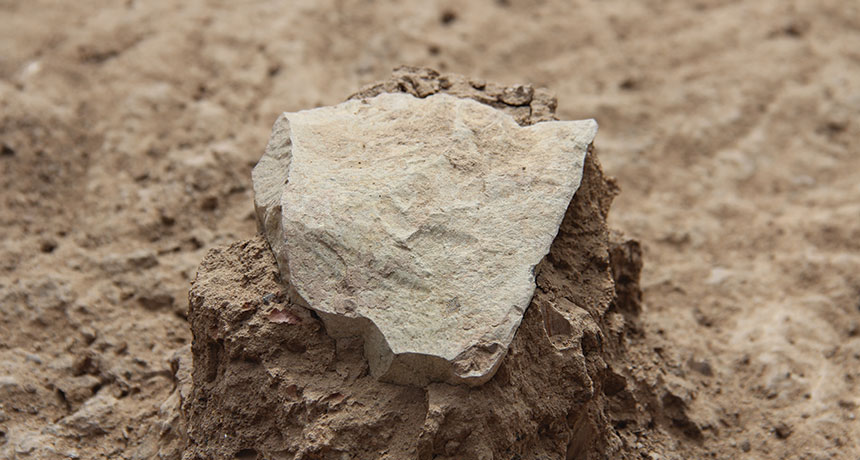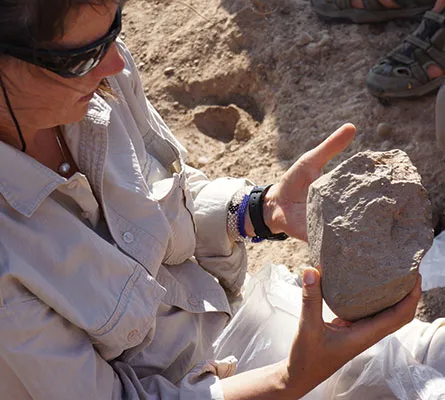Earliest known stone tools unearthed in Kenya
At 3.3 million years old, large flakes, cores predate the origin of the genus Homo

ROCK STEADY A stone tool discovered at a 3.3-million-year old site in Kenya displays edge damage where sharp pieces of rock were removed, its discoverers say.
MPK-WTAP
Excavations in an arid, hilly part of East Africa have uncovered 3.3-million-year-old stone tools, by far the oldest such implements found to date.
The tools’ age indicates that members of the human evolutionary family understood how to break stones into usable forms long before the emergence of the Homo genus, say archaeologist Sonia Harmand of Stony Brook University in New York and her colleagues. The genus Homo, which includes people today, originated around 2.8 million years ago (SN: 4/4/15, p. 8).
Hominids at Kenya’s Lomekwi 3 site made rocks into pounding tools, chiseled chunks — called cores — from which sharp flakes presumably used for cutting were removed, and platforms on which cores were pounded, the scientists report in the May 21 Nature. No fossils of hominids have been unearthed at Lomekwi 3.
“I think there are older, even more primitive stone tools out there, maybe going back 4 million years or more,” Harmand says. In her view, the Lomekwi 3 artifacts show enough knowledge of toolmaking to have had precursors.

Researchers can now use the Kenyan artifacts as references to recognize other pre-Oldowan tools, writes archaeologist Erella Hovers of Hebrew University of Jerusalem in a comment in the same issue of Nature.
In 2011 and 2012, Harmand’s team found 149 stone artifacts at Lomekwi 3. Most of the finds were classified as cores, flakes or pounding platforms. Based on analyses of the artifacts and experiments in creating modern versions of the ancient tools, the researchers suspect that hominids used two simple toolmaking methods at the ancient site. One technique involved holding a core on a platform with one hand and pounding the core with a stone held in the other hand to break off a flake. In a second flake-making approach, a core was held with two hands and pounded on a platform.
Oldowan toolmakers followed a different procedure, Harmand says. They struck a core held in one hand with a stone held in the other hand to produce a flake. That method enabled greater precision in detaching flakes with sharp edges.
Lomekwi 3 flakes are several times larger and heavier than ones that chip off rocks when wild chimpanzees crack nuts. The new finds are also massive relative to Oldowan tools. Measurements of 81 Lomekwi 3 cores, for instance, yielded an average weight of 3,096 grams (6.8 pounds). The corresponding average weight for nine Oldowan cores dating to 2.6 million years ago is 194 grams (6.8 ounces). Lomekwi 3 flakes weighed an average of 842 grams (nearly 2 pounds), whereas Oldowan flakes generally weigh no more than around 25 grams (near an ounce).
It’s hard to imagine what Lomekwi 3 hominids were doing with such enormous implements, says archaeologist David Braun of George Washington University in Washington, D.C. Harmand agrees. It’s hard to know, she says, whether large flakes were used to cut meat off animals’ bones, sharpen branches into hunting weapons or any of many other possibilities.
Braun cautions that many Lomekwi 3 cores were excavated at relatively shallow depths, raising the possibility that these artifacts shifted over time from younger to older sediments.
But Harmand’s team is confident about the age. Dating of the finds was based on their location in sediment between previously dated volcanic ash layers, as well as on soil measurements of ancient shifts in Earth’s magnetic field.
Stone tools at Lomekwi 3 certainly look like predecessors of Oldowan implements, says Stony Brook archaeologist John Shea, who did not participate in the new study. The artifacts combine elements of skill and inexperience, displaying well-crafted edges and areas of haphazard bashing, he says. “It’s a funny mix of competent stone-tool making and amateur hour.”
Editor’s note: This article was updated May 20, 2015, to correct a sentence in the third paragraph because some nonhuman animal fossils have been found at Lomekwi 3 and to clarify a comparison between Lomekwi 3 tools and rocks used by chimpanzees.






